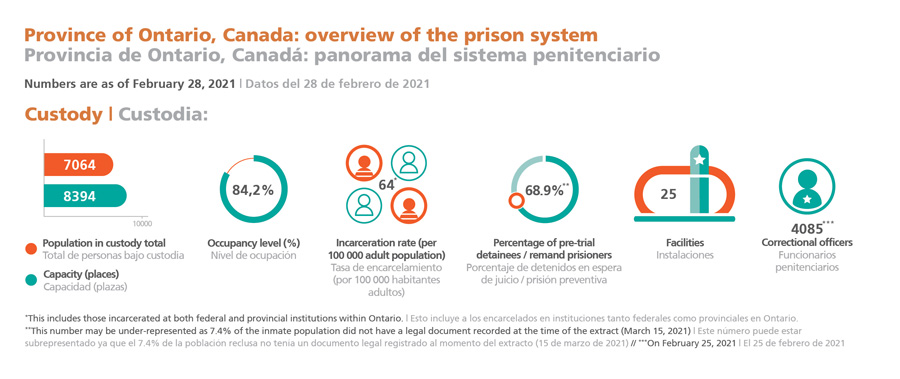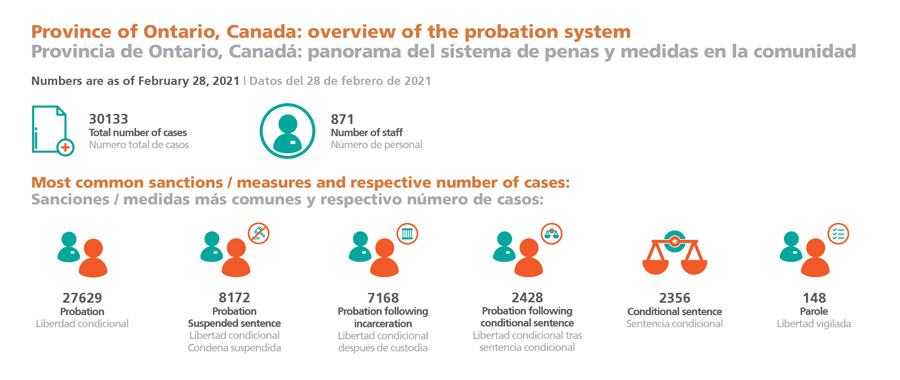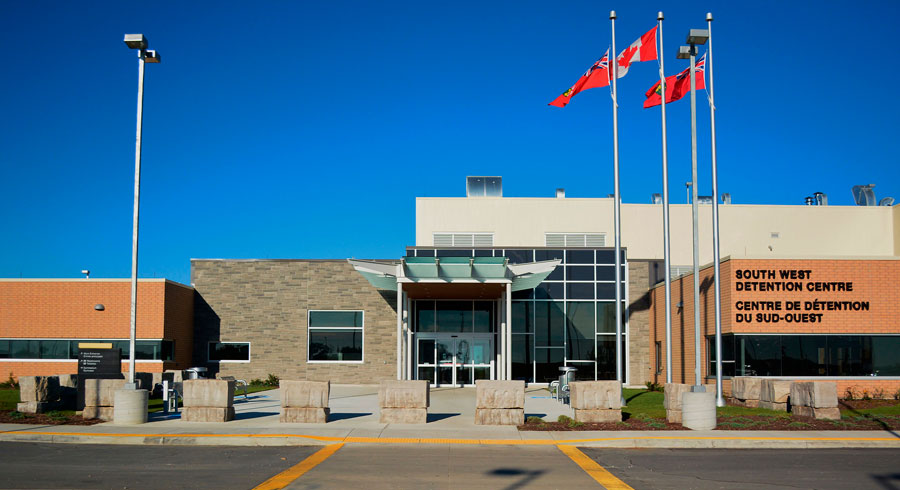Interview
Deborah Richardson
Deputy Solicitor General (Correctional Services), Ontario, Canada
During these almost two years as Deputy Solicitor General, what have been your main priorities?
DR: From a high level, my Ministry’s priorities fall into three categories: first and foremost is supporting frontline workers; second is being responsive to court decisions and legal obligations (specifically around conditions of confinement and also around mental health services and supports for inmates); and, third, working smarter.
Over the last year, we’ve also focused on managing through the COVID-19 pandemic. These categories might seem fairly broad, but we have a lot we want to achieve across the system.
Central to everything we do is our frontline staff – they’re the backbone of our system. We have thousands of staff across a geographically and demographically diverse province, working in a wide range of facilities.
As a Ministry, we feel that to understand the best next steps in our system’s evolution, it’s essential to understand our staff’s realities and needs.
I visited almost all of the 25 institutions in the province, visited probation and parole offices and did three twelve-hour job shadows with correctional officers to deepen my understanding of what our staff experience day to day.
Our Minister, Sylvia Jones, and senior leaders have made similar visits. It’s focused our thinking and helped empower us to be powerful advocates for significant new resources for corrections. A lot of the initiatives we’re discussing here today came about because of those visits.
Within frontline supports, one category we have been focusing on is recognizing and promoting the mental wellness of staff.
Correctional Services staff have a challenging job that makes them more susceptible to operational stress injuries. We’ve rolled out different supports, both clinical and non-clinical, to address a range of needs.
These include an internet-based cognitive behavioral therapy pilot project and an upcoming peer support program for all staff, the latter of which will also extend to retirees and those on leave and who may be experiencing distress of any kind.
A lot of these initiatives we’ve been able to develop jointly with our staff’s bargaining agent (union), which has been very productive.
Wellness extends to working in a safe, anti-racist environment and we’ve been supporting our front line with that too. We’ve recently developed an anti-racism action plan with staff, affinity groups and the bargaining agent.
Our goals within the plan address issues affecting our workforce and those that affect the people in provincial custody. Our employees should all feel comfortable and safe in bringing their whole selves to work.
As an employer, we feel our staff should reflect the overall labor market and those we oversee. We’re fostering equity and opportunity. As a leader, I’ve worked to ensure our senior management team is diverse and reflective of the society we serve.
Within the justice system, sadly, there is a significant over-representation of Indigenous people and Black people. It is imperative to look at all our operations – from the basics on – from an anti-racism lens.

For example, do our canteen services have appropriate products for the Black inmate haircare and skincare? With feedback from our frontline, we’re working with a vendor on sourcing culturally appropriate products. We’re also looking at programming and supports.
For Indigenous inmates, we need to make sure we have appropriate culturally sensitive supports in place, not only inside the institution, but also when they leave our doors. For that, we are putting in place better linkages with Indigenous organizations.
And, especially in areas where there’s a large Indigenous inmate population, we are working with our staff to ensure that they understand the history of residential schools, colonization, and the intergenerational trauma attached to what happened to the Indigenous community in Canada.
Ensuring that our staff have this understanding will further support our team in delivering services in a culturally sensitive way.
To support efforts like these with evidence-based decision-making, Ontario has started collecting more race-based data in many sectors, including Correctional Services, through its Anti-Racism Act 2017. This will help tremendously in terms of policy and program development.
Modernization is also an overarching theme – we’re shifting away from a paper-based system in both institutions and probation and parole offices to better support staff and operations. This is a significant challenge in a predominately paper-based sector. For example, we’re rolling out web-based scheduling tools that allow our staff to indicate their eligibility for overtime shifts from their cellphones.
We’re also rolling out mobile inmate tracking – portable handheld devices that enable us to track people coming in and out of the cell. Moreover, we have an electronic incident reporting mechanism – a platform where we can track data and trends to gain additional insights into incidents. This will play a vital role in future policy development.
For Probation and Parole Officers, we worked together with the bargaining agent to provide officers in the North with new safety devices for use when travelling through remote regions.
The new devices will help ensure the health, safety and well-being of frontline staff by providing two-way voice and text communication and enhanced live monitoring. We have also eliminated land telephone lines for Probation and Parole Officers and provided them with cell phones. Technology allows us to work smarter for the benefit of all.
JT: Ontario has infused $500 million into the correctional system over the next five years. (1)
How will this budget be allocated, and what problems will it solve?
DR: These investments represent a big step forward in the modernization of corrections, and we’ve already started making a strategic investment to address many challenges.
Firstly, we are hiring more staff and making significant capital improvements. Improving our aging infrastructure and growing our staff allows us to better deliver services, expand programming space and improve health and safety, all while supporting the fontline.
More staff allows us more opportunity to innovate as well, and with these new hires, we are exploring changing our healthcare model to have more nurse practitioners and mental health professionals lead and inform care.
Our capital improvement plan is also multi-faceted. For example, in the northern part of the province, we are building a new correctional facility. However, we didn’t want to maintain the status quo for the years it will take to build the new facility.
So, we’re undertaking infrastructure expansion projects at our existing Kenora and Thunder Bay facilities using rapid build construction. We are creating better, more culturally appropriate space, better working conditions for our staff and better living conditions for those in our custody. We’re focusing on the healing that needs to happen within our facilities.
Another big part of our investments is expanding mental health and addiction supports. I’ve mentioned this for staff, but we have been working on programs for our inmate population as well.
For example, we have partnered with Ontario Shores Centre for Mental Health Sciences to create the first dedicated mental health unit to help female inmates with severe mental health issues at our Vanier Centre for Women.
Overall, the $500 million is exciting – this historic investment will enable key projects that support both our staff and those in custody or under supervision.
COVID challenges allowed us to focus on advancing new technological solutions and innovative community reintegration initiatives. We’ll keep moving forward, one step at a time.

JT: As regards training, we have learned that in January 2020 (2) you have launched a new training program for correctional officers.
What are the objectives of this new program, and what changes are you looking to achieve with it?
DR: Seasoned correctional officers who had been there for many years felt strongly that there needed to be more initial training for new recruits within the institution’s walls and not just in a classroom.
To understand the realities of Correctional Service work, you really have to live it. It also helps with employee retention. New officers would know what to expect as their onboarding would be a combination of in-class and on the job training. This valuable feedback told us that it was important to change the training model.
We also wanted to ensure that any redesigned training program better addressed the needs of a modern correctional facility.
This included updated training on mental health, addictions, human rights, anti-racism, and core competencies such as critical and strategic thinking, emotional intelligence, communication, leadership, and professionalism.
We actively engaged staff in shaping the new program which has been named “Corrections Foundational Training” and incorporates these goals. Because of the pandemic, we had to adapt and move half of our training program online, but we have had great success to date.
We are also doing a similar redesign process with our probation and parole officer curriculum. Our updated curriculum will better address the skills required to support those with mental health and addictions issues. Moreover, it will better address how to best supervise people who may be at a higher risk to re-offend.
In addition to changes in foundational training, we’re also investing in continuous training. We are providing ongoing training to our staff on handling inmates with mental health and addiction issues.
So, since October 2020, 1,400 of our staff have completed mental health and addiction training provided through the Center for Addiction and Mental Health.
Moreover, Indigenous cultural competency training, anti-racism and specifically anti-Black racism training are being developed and rolled out. All of these training initiatives are or will be delivered through e-learning platforms.

What other modernization efforts and technological investments are underway in Correctional Services, and what impact are they expected to have?
DR: I’m working very closely with my Deputy Minister colleagues to look at ways to modernize Ontario’s justice sector, including a combination of transformative initiatives that we call criminal justice digital design.
This project aims to transform the justice system by digitizing and streamlining the lifecycle of a criminal case, from beginning to end. This transformation will allow information, documentation and evidence to be accessed on-demand and shared digitally between police, crowns, defence counsel, self-represented accused, court, judiciary and corrections personnel.
In addition to the technology implementations that I previously mentioned, the expansion of video hearings has been accelerated by the pandemic. Since the beginning of COVID, we have had 240,000 virtual appearances – over a thousand video appearances a day – through approximately 160 video units. That’s an almost 40% increase over our pre-COVID numbers.
In modernization work, you can’t underestimate the collaboration that’s required to create change. Having all the justice partners sitting at the table to walk through this journey together has helped us tremendously. Judges, Criminal Lawyers Association, Crowns, Legal Aid, Police and Corrections have been working through these complex issues together.
Of course, the pandemic has presented new challenges, including struggling with the backlog of criminal cases, particularly for those in custody. We are now able to run full trials via videoconference and deliver remote defense access, where people can use video to connect with their lawyers.
The pandemic also challenged us to find solutions related to inmate visits, and in response, we created a system to enable virtual family visits. We don’t have this service at all our institutions yet, but we are exploring options to expand.
We’re also moving forward with a new telephone system so that inmates can have more communication options, including the ability to call cell phones and better call rates.

JT: The Covid-19 pandemic has brought significant challenges to correctional services worldwide.
Given the restrictions resulting from the pandemic crisis, what kind of measures have been implemented in Ontario?
DR: COVID-19 was and continues to be an evolving public health emergency.
For the safety of our staff and those in our custody, we have to act quickly in the face of emerging issues. Establishing good communication lines – with staff and their bargaining agent, our justice partners, local superintendents and public health units – has proven essential. The benefits have been many.
Early in the pandemic, we had daily phone calls with every Union local president representing our 25 institutions (and we did similarly on the probation and parole side). This has helped us maintain morale and transparency with our staff.
Clear and frequent communication with our justice sector partners allowed us to safely and significantly reduce our inmate counts and relieve capacity pressures on the system. I feel really proud of the collaborations that we’ve had as one team.
The frontline staff are really the true heroes throughout this pandemic. Our Corrections team has done a phenomenal job, and we couldn’t be more proud.
Inmate counts is something we’ve addressed in multiple ways. We recognized that safely and responsibly reducing the number of people in provincial custody could support COVID-era service delivery while decreasing public health risk.
As part of our efforts to reduce our inmate population thus reducing the potential spread of COVID-19 within our correctional facilities we issued temporary absence permits (TAPs) to non-violent, low-risk inmates who were reaching the end of their sentence.

We also did the same for all those serving intermittent sentences, allowing offenders to serve their time within their communities.
We increased non-custodial options by introducing electronic monitoring with GPS technology. Now we’re making GPS monitoring available for bail too, which is really great. Our justice sector partners, the judiciary, crowns, and police helped tremendously decrease our inmate populations. Everyone played a key role.
We made changes at the frontline/institutional level as well: we prioritized communication and training with staff and our inmate population around health and safety protocols. We have distributed more personal hygiene supplies, and we also hired external cleaners for many of our institutions and offices. Canteen limits were also increased for inmates.
On the probation and parole side, we adjusted the staffing model with a rotation so that about 40% of staff are in the probation offices to address those high-risk and/or very vulnerable offenders while the rest are working from home and providing services to offenders remotely.
On days that staff are in the office, all staff, visitors and offenders follow health and safety protocols, including wearing face coverings and physically distancing and staff only see offenders through protective plexiglass dividers. Enhanced cleaning protocols also remain in place.
One of our latest priorities in our COVID response is discharge planning, which is particularly relevant in Ontario’s northern and remote communities.
COVID outbreaks can have disproportionate impacts on communities that don’t have easy access to doctors or hospitals. Communities wanted to ensure that there were safety protocols in place to help ensure that people returning to their communities didn’t inadvertently bring COVID with them. So we partnered with local Indigenous organizations to work on discharge planning protocols and supports. We also worked closely with the area’s Public Health Units.
Across our system, we’ve done over 25,000 COVID tests to date, which is pretty remarkable. COVID-19 has spared no system anywhere in the world. We, too, have experienced outbreaks. Thankfully our collaborative approach has allowed us to pinpoint and manage outbreaks as they happen. Our team has worked very hard to prioritize staff and inmates’ health and safety, and I’m proud of the work we’ve done to date.
Within correctional services, our job has always centered on helping people find a positive way forward from a place of difficulty.
COVID has challenged each and every one of us personally and professionally, but we’re always focused on how we can improve.
We’ve found these challenges have also allowed us to focus on advancing new technological solutions and innovative community reintegration initiatives. We’ll keep moving forward, one step at a time.
(1) Ontario government – Solicitor General. (2020). Ontario Investing in Frontline Corrections Workers.
(2) Ontario government – Solicitor General. (2020). Ontario Launches Redesigned Training Program for Corrections Officers.
Deborah Richardson
Deputy Solicitor General (Correctional Services), Ontario, Canada
Deborah Richardson, LL.B, BA, had previously served as the Deputy Minister of Indigenous Affairs. She is a seasoned intergovernmental affairs executive and Indigenous leader who began her career at a criminal law firm in Ottawa and has worked in the private, public and not-for-profit sectors. Since 2004, Deborah has held progressively more senior positions in the federal and provincial public service. Deborah is a proud Mi’gmaq woman and has strong ties to her home community of Pabineau First Nation on the north shore of New Brunswick.


